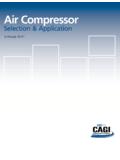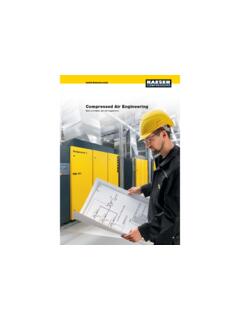Transcription of Energy efficiency in plastics processing Practical ...
1 Energy efficiency in plastics processing Practical worksheets for industry Energy worksheets 1 - 12 TANGRAMTECHNOLOGY2 Energy efficiency in plastics processing Energy efficiency in plastics processing Practical worksheets for industry Energy worksheets CONTENTS Part 1 Reducing Energy costs - the first steps ..3 Part 2 The rewards ..4 Part 3 Capital equipment selection ..5 Part 4 Injection moulding ..6 Part 5 All-electric injection moulding machines ..7 Part 6 Extrusion ..8 Part 7 Extrusion blow moulding ..9 Part 8 Drying ..10 Part 9 Cooling ..11 Part 10 Motors and drives ..12 Part 11 compressed air ..13 Part 12 Buildings ..14 Produced by Tangram Technology Ltd.
2 : 3 Energy efficiency in plastics processing Typical Site Energy Usage over Time 2468101214161820220 Unproductive operationProductive operationTimeBase loadUnproductive operationEnergy Use (kWhr)locate areas for monitoring and improvement. When are you using Energy ? The time at which you are using Energy is important and demand plotted versus time will give invaluable information on how to reduce the Energy costs (see below). Data for such plots should be available from your supply company. Look for unusual peak variations from day to day and Energy use when there is no production. A demand graph also helps you to find the base load . This is the load used for heating, lighting, compressors and pumps when you have no production at all. Another way to find the base load is to record the meter readings (in kWh) and production volumes (in kg) at the end of each shift.
3 Plot the amount of polymer processed against the Energy consumption. From the graph, the Energy use at zero production gives an idea of the base load . Reducing the base load is a sure way to make savings. Why are you using Energy ? Ideally Energy should be used only to produce good product and the most important Energy benchmark is the Energy used to process good product (in kWh/kg). This is called the specific Energy consumption (SEC) and can be found from the slope of the graph produced to find the base load. It can be compared to the industry averages to provide targets for Energy reduction. Is Energy being used to keep machines idling when they could be turned off? Are heaters running that are not being used? Are compressors running just to pump air out of leaks? Finding out why you are using Energy will reveal a wide range of possible steps for reducing Energy use.
4 How much Energy are you using? Electricity charges are based on a combination of factors (see right) and an initial survey will reveal areas for potential savings, sometimes actions as simple as changing the tariff can reduce costs at no cost! Peak demand lopping can be very effective to reduce short peaks in the maximum demand. Get free advice and help Energy management will save money and make you more competitive. Start your Energy management programme today and reap the benefits of improved profits by cost effective investment and management. Action Energy provides free resources for Energy management and cost reduction in plastics processing . An initial handbook Energy in plastics processing - a Practical guide (GPG292) gives essential information on how to start reducing your Energy costs and signposts further free information.
5 Get the information, save the money and become more competitive! Reducing Energy costs - the first steps The Climate Change Levy will increase the cost of electricity by and the base Energy generation costs are rising throughout the world. Energy costs are always somebody else s problem and the plastics processing industry generally regards the Energy as an overhead and as a fixed cost. This is untrue and Energy is both a variable and a controllable cost. Most processors could easily reduce Energy costs (without large investments) and increase profits through simple good Energy management practice. This series aims to show you how to reduce Energy usage and increase your profits. The vital questions Before you can start to reduce your Energy costs you need to understand where, when why and how much Energy you are using. This information provides the benchmarks and signposts for improvement.
6 Where are you using Energy ? The main electrical Energy users are motors and drives, heaters, cooling systems and lighting systems. A simple site Energy distribution map will show where Energy is being used. If you are using a single meter it may be cost effective to use sub-meters to get further information on the areas of high Energy use. Sub metering allows you to start to calculate the cost of Energy for each operation and to identify areas of high Energy usage - a key factor in reducing Energy costs. A first step is to produce an Energy map of your site to Energy is a variable and a controllable cost Key tips for reducing the cost of electricity Maximum Power Requirement is the maximum current a site can draw at the supply voltage. Reduce the cost by: Staggering start-ups. Matching the MPR to the requirements. Getting the MPR right for new premises to avoid costly charges.
7 Negotiating an annually based MD instead of an MPR charge. Maximum Demand is the current drawn at the supply voltage averaged over half an hour. Reduce the cost by: Staggering start-ups. Giving machinery time to stabilise before starting up new processes. Power Factor is a measure of the phase shift created by machinery. Lightly loaded machinery tends to have a high phase shift, and a low power factor. Improve the power factor by running electric motors efficiently to get power factors close to 1. Load Factor is a measure of the hours per day that the user draws from the supply. Reduce the cost by: Running for greater than a single shift. Carrying out some operations outside the main shift pattern regrinding. 4 Energy efficiency in plastics processing PolymerTransportHeatFormCoolTransportPos t-ProcessEnergyEnergyEnergyEnergyEnergyE nergyProductServices and buildings Energy needsThe questions to ask (and answer) Which areas have the largest electrical load?
8 (look for the largest machines, they will most likely also have the largest motors and create the largest load, when they are used). Is the thermal insulation, if present, on all the machines in good condition? If there is no insulation then why not? Look for signs of machines that are not in production but have motors or ancillary equipment running ( conveyors, pumps, granulators, fans, machine heaters). Are there any good reasons why machines need to be kept idling to be ready for the next production run? Which motors are left running when not doing productive work? Why are the motors the size they are and would a smaller motor be more efficient? Which cooling water pumps (and chillers) and vacuum pumps are still running? Is the airflow from fans being throttled back with dampers and could variable speed drives be used instead?
9 Look for areas of Energy use where no productive work is being carried out and yet machines are running and using Energy . Look for water, air or steam leaks. Where can you hear steam and compressed air leaks? The hissing noise you hear from leaks is costing real money. If there is no production being carried out then why is the compressed air system still running? Is compressed air being used for expensive applications where other cheaper methods can be used? cleaning or drying. Does the compressed air pressure need to be so high, or the vacuum so low? The rewards Energy efficiency measures can improve your profits significantly for minimum effort and costs. For a plastics company with a turnover of 10 million per year and a net profit of 10% then the profit will be 1 million. The average electricity bill will be approximately 200,000 (between 1 and 3% of turnover).
10 Simple no-cost or low-cost Energy reduction practices can reduce this by a minimum of 10% (and up to 20%) and increase profits by at least 2%. This is the equivalent of adding sales of 200,000 to turnover and is a worthwhile investment by any standards. The initial site Energy survey The objective of an Energy survey is to gain an overview of the general site Energy use. It is a walk around the site with an Energy manager s hat on. This will identify some rapid no-cost or low-cost improvements that can be made to save money. The survey should be carried out as soon as possible - if Energy is being wasted now, it is costing money now. The diagram shows the main areas of Energy use in plastics processing . Use this as a guide during your walk-around to look for areas of high or unnecessary Energy usage. How do you do a site survey? Take an unannounced walk around the site at around mid-shift.















